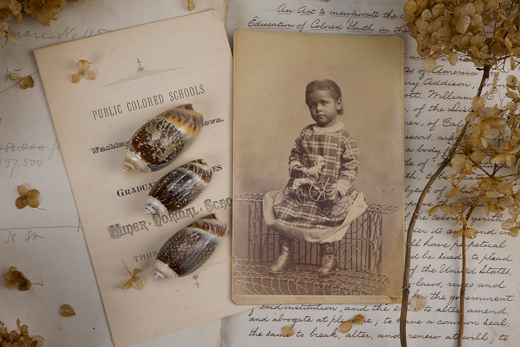Vignettes of Civil War-era materials from Emory's Manuscript, Archives, and Rare Book Library (MARBL), accented with other items reminiscent of the time period, are the subjects of "What Must Be Remembered," a small photographic on display at Emory's Schwartz Center for the Performing Arts.
The compositions were created using photos, letters, journals and other ephemera and books drawn from several collections at MARBL, including its Civil War collections and the Robert Langmuir African American Photograph Collection.
The exhibit was inspired by the Civil War poem "Native Guard" by Natasha Trethewey, the current two-term U.S. Poet Laureate and the director of Emory's creative writing program. The poem begins with an epigraph by Frederick Douglass: "If this war is to be forgotten, then I ask in the name of all things sacred what shall men remember?"
Pellom McDaniels III, faculty curator of MARBL's African American Collections and Emory associate professor of African American Studies, and Paige Knight, Emory Libraries archival photographer and digital photography coordinator, are co-curators of the exhibit, which will run through the end of February.
Reflections of life
The five photographs reflect on aspects of African American life during the war, including womanhood, manhood, labor and commerce, childhood and education, and life as a soldier.
Knight created the compositions using MARBL materials selected by McDaniels, as well as other items they both contributed such as shells, dried flowers, old pocket watches, and 19th century clay marbles, which emphasizes the three-dimensionality of the lives of African Americans as a whole.
"The photographs extend the dialogue with the poem; they provide a sense of time, place, ideals, and opportunities. In essence, we created a collection of curated memories for this exhibition," Knight says.
"I really hope we can attract new researchers to MARBL as well," McDaniels says. "If we can create these types of spaces to demonstrate how our materials can be used, I think more people will be attracted to us as a resource — artists, in particular, who can use MARBL materials for their purposes."

